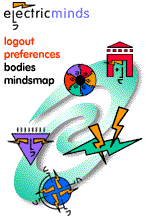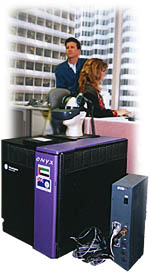
|

|

Virtual Reality Rolls Up Its Sleeves Folks continually question the efficacy of virtual reality. VR developers hear it all the time. It's not that people disbelieve VR's promise or cleverness. No one contests VR's usefulness in amusement parks or Michael Crichton fiction. Again and again, however, VR developers meet with smirks of doubt when broaching the pragmatic, hammer-and-nails, floss-and-toothpick applicability of VR in business and industry. This is why I've journeyed on a quest for the past four months, a journey that prevented me from posting fresh words here. I'm back, with fresh words, and a fresh outlook on the status of VR. On three separate field trips, I traveled with a 3-person film crew around the States, documenting production (as opposed to research) applications of advanced, immersive virtual reality at world-famous companies. The finished product will be a 15-minute documentary, due out next month. Most people typically associate virtual reality with crunchy granola-tofu-low-fat-decaf-latte personalities. I'm here to testify that VR is being wielded by meat-and-potatoes types in Dubuque (Iowa), St. Louis, Detroit, Philadelphia, Atlanta, Boston, Baltimore, Palo Alto and San Francisco. These aren't the only places where VR rolls up its sleeves, but they're the cities where we filmed people using VR to solve production problems. We also gathered footage of engineers and designers in Denmark, Italy, Germany, and England, where implementing VR technology is as practical as, well, hammering out connecting rods for car engines. Whoa, I'm getting ahead of myself. Let's back up and I'll give you a report summarizing some of our adventures. In mid-November, we visited Chrysler and General Motors, both in the Detroit area. At General Motors we filmed their remarkable, extremely high-res and well-tuned CAVE. At Chrysler we documented how the engineering group evaluates visibility and other human factors issues in their virtual car prototypes, using the Fakespace BOOM stereo display and Virtual Technologies Cybergloves. Both companies have been acclaimed in computer graphics and design engineering journals for their innovations. On our next trip, in the first week of December, we shot footage of EEs and execs in San Francisco, Philadelphia, Dubuque and St. Louis (in that order). In downtown San Francisco, we watched Bechtel's Technology & Consulting Group engage in collaborative, networked VR design reviews of engineering projects in this case, the international airport of Dubai in the Middle East. The next day we awoke in downtown Philadelphia and jammed over to Raytheon Engineers and Constructors. There we interviewed engineers and designers about how they use VR for process plant design, simulation, sales and marketing. Then we flew from Philly to St. Paul, clambered up an icy staircase into a 15-seat TurboStream bound for Dubuque, Iowa, where we landed in a blizzard. Say, have you ever been to Dubuque Airport? It's cute, for an airport. It has its own non-franchise short-order grill run by a lovely lady named Doris who makes a chunky BLT and sells the souvenir Dubuque keyring. When we carried our suitcases and Anvil cases into Dubuque Airport after a day of shooting, the ticketing agents remembered us from our arrival the previous day, and bumped passengers off our outbound flight to ensure that the aircraft's protruding belly would safely carry our video, audio and lighting gear (hey, it's not often that a documentary on VR is shot in Dubuque, home of John Deere Industrial Equipment Division, where VR helps determine the ergonomic suitability of wheel-loaders and bulldozer prototypes). Nonetheless, our cameraperson insisted that we provide her $70,000 digital video camera with its own seat, lest the camera bounce and freeze in the cargo area below deck. For once I didn't care that she treated her technology as if it were her child (not the first person we've met like that, eh?) because I was too busy angsting about flying in a snowstorm in a 13-seat propeller putt-putt. And this served as a reminder that the virtual world will never, in our lifetime, replicate the real world, and that's not the point of VR, anyway. But I digress. The next day we awoke in St. Louis, and navigated to McDonnell Douglas headquarters. We filmed their collaborative, two-person, headmount-equipped supportability design review system. In this application, two engineers interact with each other and with the same interactive virtual prototype in this case, an F-15 jet in the same virtual environment. Ground-breaking stuff. And last week we flew to Ford, where we saw how the venerable Vulcan Forge plant uses VR to train workers in the art of stamping connecting rods, using Division software, a Polhemus-tracked Virtual Research headmount, and a custom force-feedback system. At Ford we chatted with Nate Jennings. Ask Mr. Jennings if he considers VR a "practical tool" and he'll say he didn't know it was anything else. Mr. Jennings is the world's first auto worker to be taught to operate a connecting-rod forging hammer in immersive VR, before he ever got his hands on the real thing: a fire-breathing, red-hot, steel-stamping machine, the operation of which requires precise hand-eye-foot coordination (along with strength and guts, but those traits aren't covered in any training simulation yet). At every site I asked the same question, "What is your primary challenge in implementing virtual reality technology?" Every person at every company provided the same answer: that challenge is conceptual. Each group originally encountered skepticism and smirks of doubt when proposing production applications of VR at their company in each case a multinational industrial behemoth that has long prided itself on technological innovation. Yet even at such organizations, visionaries find that senior management is initally reluctant to invest in VR, because execs widely view it as an entertainment technology. This is a primary reason for producing this documentary: to help educate viewers on the value of VR as an unprecedented problem-solving tool and communications medium. We go into the studio next week for post-production, and I'll post you on our progress. |
immersion said: I loved talin's description of electric reality, virtual hallucinations. The mixture of fantasy and technoreality is enlivening and fresh in a way that is so hard to achieve for people like me who thoughts are dominated by hypothetico-deductive scientific empiricism. Your novel world presents an alluring alternative reality. I have a much stodgier approach to VR, trying to decipher how the human mind works from its interactions with the limited representations of reality that goggles offer. It can be exciting at times when a new insight offers itself from the strange perceptions of these semireal environments. I see now how the sense of self in a seeing person is dominated by the reference frame of space, and our understanding is derived from metaphoric extensions of spatial structures and dynamics, that overpower the temporal and melodic sequences of our lesser senses. How I wish I could sing the sense of space! Most Active Topics: Topic 1 Innerductions Topic 3 OSMOSE and the Future of Immersive Experience Topic 22 The Wired Brain? | |||
| ||||
Also in Immersion Quest: Virtual Reality Rolls Up Its Sleeves Come On In, The Data's Fine! Being There Here: How and Why | ||||
|
electric minds |
virtual community center |
world wide jam |
edge tech |
tomorrow |
conversations
Any questions? We have answers.
©1996, 1997 electric minds, all rights reserved worldwide.
|


